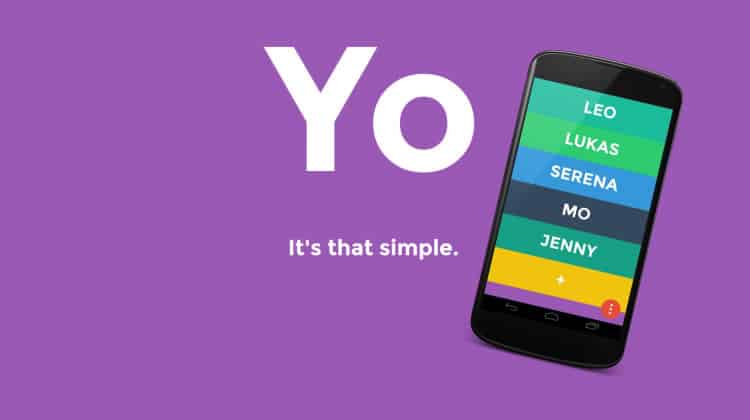
People often say that there’s an app for everything – and Yo! could be the very proof of that statement. Its single function is to allow users to send ‘Yo’ in the form of a simple text message. Yes, that’s it. It does nothing else.
Indeed we have already said that one of the cardinal usability rules for mobile sites and apps is to keep it simple. We have also said that single purpose systems can indeed be usable.
Yo! has both attributes. It is very simple in both functionality and user interface and it only has a single purpose. So from a theoretical perspective, it is a mobile app that has a high degree of usability. Yet at the same time it makes you wonder if usability is the only secret for its success.
Quick facts first: Yo! Is undoubtedly one of the hottest new apps on the market right now, with over a million downloads (and counting). It’s reached the top 3 in the iOS App Store. Major news publications such as The New York Times have featured it, while it’s even been discussed on a major US talk show. It’s also inspired a couple of spoof apps, including one based on HBO’s Game of Thrones. Unsurprisingly, the chosen replacement greeting is ‘Hodor’.
But does Yo! have any real long term potential, or is it just riding a viral wave that will end as abruptly as it started? You may think it’s a little crazy, but we think it may have some traction. And that’s not just a gut feeling either, but an argument based on facts and figures.
How It Started
The app’s creator Or Arbel cobbled Yo! together in a mere eight hours. It was launched on April Fool’s Day earlier this year, which just about gives you the initial intention of the app. Released on Android only, there were no delusions of grandeur when it was first released.
But Wait, What Does Yo! Really Do?
Many people think that the app’s purported functionality is a gimmick – surely there’s more to it? Well, the answer is one of those annoying ‘yes and no’ editions.
The main mission of the app is to simplify the sending of a single message. You can literally send out a ‘Yo’ to a friend with just a single tap. The same message on Snapchat, Facebook, or WhatsApp would take you 11 taps. But of course, you’re limited to ‘Yo’ and nothing else.
So essentially, yes, the app only sends out a ‘Yo’. However, it can mean different things. For example, recently added functionality allows bloggers to send out a message to subscribers that let them know new content has been released. And that’s the kind of trend we expect to see in future.
But what Arbel really thinks is the power of Yo! is the fact that it’s a message wrapped in a context. It can mean whatever you want it to mean, whether it’s a note to say you’re home or a sign that you’re in trouble. And that’s the power that drives the long term potential of the app.
The Snowball Effect

Despite being a basic app with code that’s not exactly complex, it nevertheless started to take on a snowball effect. The viral interest has led to serious money being invested in the company (yes, it’s now a company), to the tune of over $1 million USD.
Ever since then, however, things have snowballed. Arbel, the creator, left a lucrative position of the stock-trading platform Stox to work on the app on a full-time basis. Yo! has been released on iOS and Windows, functionality is being added, and it’s even had the ‘honor’ of being a victim of a hack attack. That wouldn’t happen to a run-of-the-mill app – hackers only focus on stuff that’s popular and used by many people.
The investments make Yo! a legit undertaking. It’s not a couple of guys working out of a basement and hoping something happens. That’s already behind us. Yo! now has some serious backing and time and effort is being invested by a team of brainboxes to make the app a financial success.
The Technical Potential
The blogger functionality is just the beginning. We think the app is going to add further functionality, such as having the capability of adding links, notifications, photos, videos, and more. All driven through the phrase ‘Yo’.
The trick will be whether Yo! can maintain its simplicity while still adding functionality that makes the app useful. If it stays in its current form, the app will be nothing more than a viral fad. However, if it can stick to its ethos of streamlined technology and fewer taps to do the same thing, people will stay interested.
Another key factor is whether other popular platforms and apps look for integration. IFTTT, a huge time saver and popular app, has recently launched a dedicated channel for Yo!. It allows a link between the app and other devices, such as home lighting controllers (Philips’ Hue, to be precise). If we start seeing more of that, it’ll be more than a good sign for the future of Yo!.
Final Thoughts
Ultimately, we can’t say for certain whether Yo! is just a flash in the pan project or something that will end up being a household name. However, we don’t think it’s just a summer fad. The amount of downloads, the social buzz, the media coverage, and financial investment means that the company is making a serious effort to stick around for the long haul. And we’re intrigued to see whether they can make something happen.
Want to learn more?
Want to get an industry-recognized Course Certificate in UX Design, Design Thinking, UI Design, or another related design topic? Online UX courses from the Interaction Design Foundation can provide you with industry-relevant skills to advance your UX career. For example, Design Thinking, Become a UX Designer from Scratch, Conducting Usability Testing or User Research – Methods and Best Practices are some of the most popular courses. Good luck on your learning journey!
